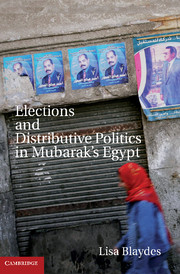Book contents
- Frontmatter
- Contents
- List of Figures
- List of Tables
- Acknowledgments
- 1 Introduction
- 2 Political and Economic Change since 1952
- 3 Elections and Elite Management
- 4 The Politics of Infrastructure Provision
- 5 Electoral Budget Cycles and Economic Opportunism
- 6 Vote Buying, Turnout, and Spoiled Ballots
- 7 Elections and Elite Corruption
- 8 Elections and the Muslim Brotherhood
- 9 Liberal Intellectuals and the Demand for Democratic Change
- 10 Foreign Pressure and Institutional Change
- 11 Egypt in Comparative Perspective
- 12 Conclusion
- Bibliography
- Index
2 - Political and Economic Change since 1952
Published online by Cambridge University Press: 04 February 2011
- Frontmatter
- Contents
- List of Figures
- List of Tables
- Acknowledgments
- 1 Introduction
- 2 Political and Economic Change since 1952
- 3 Elections and Elite Management
- 4 The Politics of Infrastructure Provision
- 5 Electoral Budget Cycles and Economic Opportunism
- 6 Vote Buying, Turnout, and Spoiled Ballots
- 7 Elections and Elite Corruption
- 8 Elections and the Muslim Brotherhood
- 9 Liberal Intellectuals and the Demand for Democratic Change
- 10 Foreign Pressure and Institutional Change
- 11 Egypt in Comparative Perspective
- 12 Conclusion
- Bibliography
- Index
Summary
Although parliamentary elections took place in Egypt during the late 1800s, historians have identified two significant periods of multiparty politics in the country (Beattie 2000). The first occurred following the promulgation of the 1923 constitution, after the British declared an end to the protectorate and Egypt became an independent state. The second began in 1976 under President Anwar al-Sadat and continues through the rule of Hosni Mubarak. Although the focus of this book is on an electoral authoritarian equilibrium that has emerged under Mubarak, this chapter seeks to explain some of the dynamics that have led the authoritarian regime in Egypt to converge on this particular set of institutions.
The history of institutional change in Egypt suggests two seemingly contradictory facets. On one hand, the Egyptian experience supports Heydemann's contention that authoritarianism has proven to be an adaptive, highly flexible style of rule (2007b, 22). Egyptian political institutions have evolved over time to accommodate changing circumstances and exigencies. At the same time, Egyptian institutions have also exhibited a degree of path dependence. Pierson (2004) argues that there tends to be some institutional stickiness associated with inherited social arrangements; in other words, there is a status quo bias in political institutions. In the case of Egyptian electoral institutions, options available to the ruling regime have been constrained, to some degree, by the country's past political experiences and institutions.
- Type
- Chapter
- Information
- Elections and Distributive Politics in Mubarak’s Egypt , pp. 26 - 47Publisher: Cambridge University PressPrint publication year: 2010



